Goniothalamus cheliensis is a species of plant in the Annonaceae family. It is native to China and Thailand. Bioactive molecules isolated from its roots have been reported to have cytotoxic activity in tests with cultured human cancer cells.
Goniothalamus elegans is a species of plant in the family Annonaceae. It is native to Thailand and Vietnam. Suzanne Jovet-Ast, the French botanist who first formally described the species, named it after its elegant thin, flexible leaves.

Goniothalamus giganteus is a species of plant in the family Annonaceae. It is native to Malaya, Myanmar, Sumatra and Thailand. Joseph Dalton Hooker and Thomas Thomson, the British botanists who first formally described the species, named it after its exceptionally large flowers.
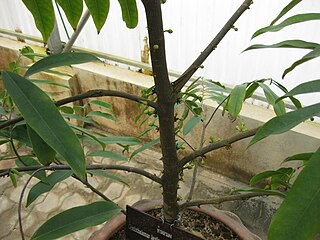
Goniothalamus laoticus is a species of plant in the family Annonaceae. It is native to Laos and Thailand. It was originally described by the French botanists Achille Eugène Finet and François Gagnepain using the basionym Mitrephora laotica. In Thailand it is commonly called Khao Lam-dong and is used as a traditional medicine.
Goniothalamus latestigma is a species of plant in the family Annonaceae. It is native to Myanmar and Thailand. Cecil Ernest Claude Fischer, the botanist who first formally described the species, named it after its broad stigmas.

Goniothalamus macrophyllus is a species of plant in the family Annonaceae. It is native to Borneo, Java, the Malay Peninsula, Sumatra and Thailand. Carl Ludwig Blume, the German-Dutch botanist who first formally described the species using the basionym Unona macrophylla, named it after its large leaves. It is commonly called Penawar Hitam in the Malaya Peninsula, Ki Cantung in Indonesia, Limpanas Putih in Brunei, and Chin Dok Diao in Thailand.
Goniothalamus maewongensis is a species of plant in the family Annonaceae. It is native to Thailand. Richard M.K. Saunders and Piya Chalermglin, who first formally described the species, named it after the Mae Wong National Park in Thailand where the type specimen was collected.
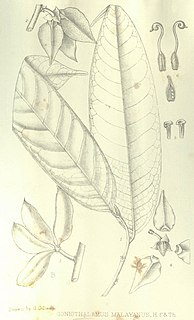
Goniothalamus malayanus is a species of plant in the family Annonaceae. It is native to Borneo, the Malay Peninsula, the Nicobar Islands, Sumatra and Thailand. Joseph Dalton Hooker and Thomas Thomson, the British botanists who first formally described the species, named it after part of its habitat range, British Malaya.

Goniothalamus ridleyi is a species of plant in the family Annonaceae. It is native to Borneo, Peninsular Malaysia, Sumatra and Thailand. George King, who first formally described the species, named it after the English botanist Henry Nicholas Ridley who collected the specimen King examined.
Goniothalamus rongklanus is a species of plant in the family Annonaceae. It is native to Thailand. Richard Saunders and Piya Chalermglin first formally described the species and named it after Phu Hin Rong Kla National Park in Thailand.
Goniothalamus gabriacianus is a species of plant in the family Annonaceae. It is native to Cambodia, the province of Hainan China, Laos, Thailand and Vietnam. Henri Ernest Baillon the French botanist who first formally described the species using the basionym Oxymitra gabriaciana, named it after Paul-Pierre Gabriac, a French civil servant in Vietnam, who provided one of the specimens that he examined.
Goniothalamus sawtehii is a species of plant in the family Annonaceae. It is native to Myanmar and Thailand. Cecil Ernest Claude Fischer the botanists who first formally described the species, named it in honor of Maung Saw Teh, a plant collector who provided the specimen examined by Fischer.

Goniothalamus scortechinii is a species of plant in the family Annonaceae. It is native to Peninsular Malaysia and Thailand. George King, the British botanist who first formally described the species, named it in honor of Benedetto Scortechini, an Italian priest and member of the Linnean Society of London and New South Wales who collected many important botanical samples in Peninsular Malaysia.
Goniothalamus tamirensis is a species of plant in the family Annonaceae. It is native to Cambodia, Laos, Peninsular Malaysia, Thailand and Vietnam. The French botanists J.B. Louis Pierre and François Gagnepain, who first formally described the species, named it after the region in Cambodia it was collected from, which they record as “monts Tamir”.

Goniothalamus tapis is a species of plant in the family Annonaceae. It is native to Peninsular Malaysia, Sumatra, and Thailand. Friedrich Anton Wilhelm Miquel, the Dutch botanists who first formally described the species, named it after a local vernacular name, Kajoe-tapis, from Pariaman Sumatra where the specimen he examined was found.
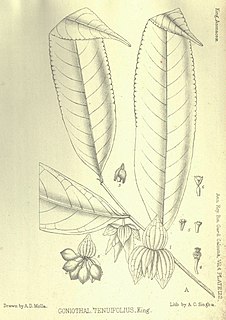
Goniothalamus tenuifolius is a species of plant in the family Annonaceae. It is native to Peninsular Malaysia, Thailand and Vietnam. George King, the British botanist who first formally described the species, named it after its slender leaved foliage.
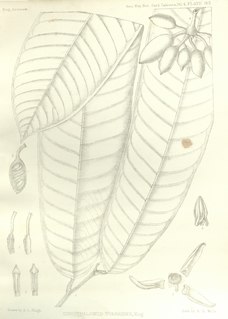
Goniothalamus uvarioides is a species of plant in the family Annonaceae. It is native to Peninsular Malaysia and Thailand. George King, the British botanist who first formally described the species, named it after its fruit which he thought resembled those of the genus Uvaria more than those of Goniothalamus.
Mitrephora alba is a species of plant in the family Annonaceae. It is native to Peninsular Malaysia. Henry Nicholas Ridley, the English botanist who first formally described the species, named it after its white flowers.

Mitrephora keithii is a species of plant in the family Annonaceae. It is native to Myanmar, Peninsular Malaysia and Thailand. Henry Nicholas Ridley, the English botanist who first formally described the species, named it in honor of Dr. A. Keith who collected the sample that Ridley examined.
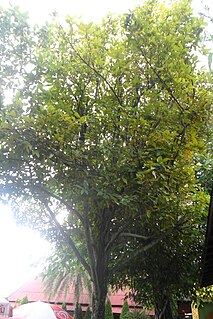
Mitrephora winitii is a species of plant in the family Annonaceae. It is native to Myanmar and Thailand. William Grant Craib, the British botanist who first formally described the species, named it after Phya Winit Wanandor, the Thai botanist who collected the specimen that Craib examined. In the Prachuap Khiri Khan province of Thailand it is commonly referred to as Mahaphrom.










